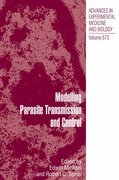
It is clear that many fascinating problems still remain to be addressed in parasite transmission modelling, from better understanding of transmission processes and natural history of infection to investigating the impact of ecological and spatial scales, climate change, host immunity and social behaviour, parasite-host evolutionary dynamics and parasite community ecology on parasite transmission. This book captures some of the advances made in recent years and provides indications of ways forward for addressing these questions by shedding light on developments in conceptual frameworks and modelling tools as well as the emergence of new data forms for aiding model construction, testing and analysis. Another important advance has been the parallel development of robust computationally-intensive statistical methods to allow model testing and parameterization by aiding the fitting of models to complex data. This is an exciting area of work, which we believe will broaden the scope of mathematical modelling in investigating parasite transmission processes. In particular, we expectthis advance will now allow modellers to begin the successful development andanalysis of mechanistically-rich models of parasite transmission that will facilitate better integration of the variety of mechanisms increasingly recognized as important in simultaneously affecting transmission, including abiotic processes, trophic and evolutionary interactions, movement in space, and behaviour and even physiology of the individual. We foresee a continuing bright future for using mathematical modelling to clarify parasite transmission dynamics and address problems related to effective parasite control. Ultimately, throughthis improved application of models to research and management, we expect that parasite control would be an achievable goal bringing benefits to a vast number of our fellow human beings. Presents the progress made in terms of both the conceptual and practical advances made in addressing key gaps in parasite transmission modelling, the new understanding these have yielded regarding the transmission and control of these parasites, and the future challenges they portend for population dynamics modelling Captures some of the advances made in recent years and provides indications of ways forward for addressing these questions by shedding light on developments in conceptual frameworks and modellingtools as well as the emergence of new data forms for aiding model construction, testing and analysis Parallel development of robust computationally-intensive statistical methods to allow model testing and parameterization by aiding the fitting of models to complex data INDICE: Part 1. Modelling Parasite Transmission Progress in Modelling Malaria Transmission.- Vector Transmission Heterogeneity and the Population Dynamics and Control of Lymphatic Filariasis.- Modelling Multi-Species Parasite Transmission.- Metapopulation Models in Tick-Borne Disease Transmission Modelling.- Modelling Stochastic Transmission Processes in Helminth Infections.- Modelling Environmentally-Mediated Infectious Diseases of Humans: Transmission Dynamics of Schistosomiasis in China. Part 2. Application of Models to Parasite Control Parameter Estimation and Site-Specific Calibration of Disease TransmissionModels.- Modelling Malaria Population Structure and Its Implications for Control.- Mathematical Modelling of the Epidemiology of Tuberculosis.- Modelling Trachoma for Control Programes.- Transmission Models and Management of Lymphatic Filariasis Elimination.- Disease Transmission Models for Public Health Decision-Making: Designing Intervention Strategies for Schistosoma japonicum. Epilogue Modelling Climate Change and Malaria Transmission.- Modelling the Transmission of Trypanosomacruzi: The Need for an Integrated Genetic Epidemiological and Population Genomics Approach.
- ISBN: 978-1-4419-6063-4
- Editorial: Springer
- Encuadernacion: Cartoné
- Páginas: 212
- Fecha Publicación: 29/04/2010
- Nº Volúmenes: 1
- Idioma: Inglés
